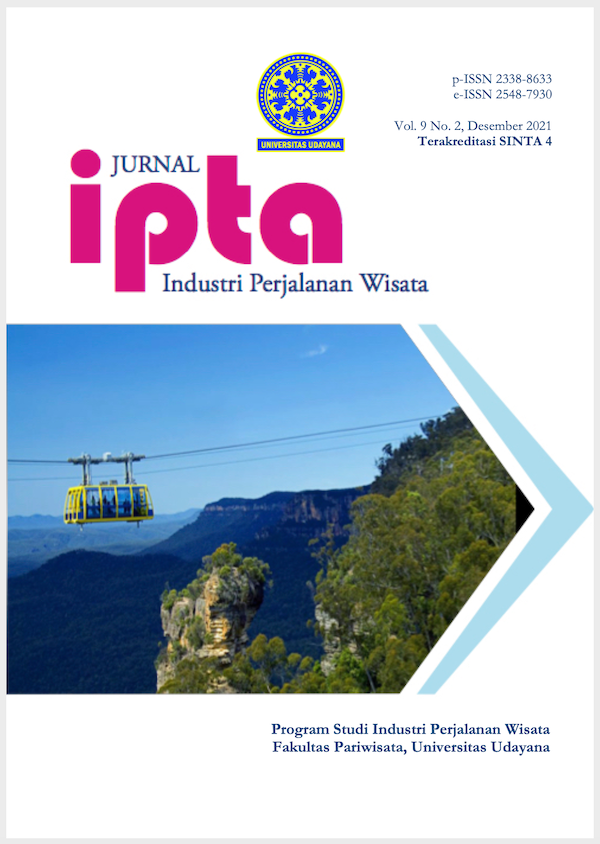PENGARUH TERPAAN INFORMASI PANDEMI COVID-19 TERHADAP LOYALITAS WISATAWAN BERWISATA DENGAN MINAT BERKUNJUNG SEBAGAI VARIABEL MEDIASI
Abstract
This study discusses the role of the media in conveying information which changes the perceptions, attitudes, and behavior of the audiences. National TV, mass media, and electronic media provide information on the spread of COVID-19 nationwide every day, thus giving a negative impact on tourism development. The tourists do not dare to move out of the area or even travel. This explains that the media can influence the interest of tourists to travel. On the other hand, information media related to COVID-19 aims to handle the spread of COVID-19 optimally. However, since the news of COVID-19, tourists are afraid to move or travel. Loyalty of tourists traveling has decreased. The purpose of this study was to determine the relationship between exposure to information on the COVID-19 pandemic on the interest and loyalty of tourists traveling. The data were collected using a questionnaire with a Likert scale measurement scale. While the data analysis technique uses smart PLS. The results of this study suggested 1) there was a positive and significant direct effect between information exposure on visiting interest, 2) there was no positive nor significant direct effect between information exposure on tourist loyalty, 3) there was no positive nor significant direct influence between visiting interest on loyalty of tourists traveling, and 4) there was an indirect effect between exposure to information on loyalty through tourist interest as a mediating variable.
Downloads
References
Agusli, D., & Kunto, Y.S. (2013). Analisa Pengaruh Dimensi Ekuitas Merek terhadap Minat Beli Konsumen Midtown Hotel Surabaya. Jurnal Manajemen Pemasaran Universitas Kristen Petra Surabaya, 1(2), 1-8.
Biocca, F., & Harms, C. (2002). Defining and measuring social presence: Contribution to the Networked Minds Theory and Measure. https://www.researchgate.net/publication/228887603_Defining_and_measuring_social_presence_Contribution_to_the_networked_minds_theory_and_measure
Carpenter, J. P., & Harvey, S. (2019). “There’s no referee on social media”: Challenges in educator professional social media use. Teaching and Teacher Education, 86, 102904. https://doi.org/10.1016/j.tate.2019.102904
Chemli, S., Toanoglou, M., & Valeri, M. (2020). The impact of Covid-19 media coverage on tourist’s awareness for future travelling. Current Issues in Tourism. https://doi.org/10.1080/13683500.2020.1846502
Effendy. (2003). Ilmu Teori dan Filsafat Komunikasi. Bandung: PT. Citra Aditya Bakti.
Flores-Ruiz, D., Elizondo-Salto, A., & Barroso-González, M. D. L. O. (2021). Using social media in tourist sentiment analysis: A case study of andalusia during the Covid-19 pandemic. Sustainability (Switzerland), 13(7), 1–19. https://doi.org/10.3390/su13073836
Hurlock. E. B. (1995). Personality Development. New Delhi: Tata McGraw-Hill.
Ingram, C., Themistocleous, C., Rickly, J. M., & McCabe, S. (2021). Marketing ‘Literary England’ beyond the special interest tourist. Annals of Tourism Research Empirical Insights, 2(2), 100018. https://doi.org/10.1016/j.annale.2021.100018
Laba. IN., Semara, IM.T., & Tunjungsari, K.R. (2018). Dampak Terpaan Informasi Media Digital Terhadap Perkembangan Pariwisata dan Perilaku Masyarakat Bali. Jurnal Kajian Bali, 8(2), 177-196
Liu, X., Mehraliyev, F., Liu, C., & Schuckert, M. (2020). The roles of social media in tourists’ choices of travel components. Tourist Studies, 20(1), 27–48. https://doi.org/10.1177/1468797619873107
Marta, R.F., & William, D.M. (2016). Studi Terpaan Media Pemasaran Melalui Posting Instagram Terhadap Ekuitas Merek Pelanggan Sumoboo! (Analisis Eksplanatif pada Komunitas Food Blogger #WTFoodies). Jurnal Komunikasi, 8(1), 68-82.
Messaris, P. (1996). Visual Persuasion the Role of Images in Advertising. California: Sage Publications.
Munawwaroh, P. R., (2018). Pengaruh Terpaan Media Pada Akun Instagram @Exploresiak Terhadap Minat Kunjungan Wisata Ke Siak Sri Indrapura. JOM FISIP, 2-12.
Nariswari, M.A.S., & Putra, I.B.W. (2021). Implikasi Kebijakan PSBB dan Protokol Kesehatan Covid-19 Terhadap Minat Wisatawan Berkunjung ke Bali. Kertha Desa, 9(5), 45-57
Nazir, M. U., Yasin, I., & Tat, H. H. (2021). Destination image’s mediating role between perceived risks, perceived constraints, and behavioral intention. Heliyon, 7(7), e07613. https://doi.org/10.1016/j.heliyon.2021.e07613
Noordiono, A. (2016). Karakter Generasi Z dan Proses Pembelajaran Pada Program Studi Akuntansi. Skripsi thesis, Universitas Airlangga
Pastika, I W. (2013) Dinamika Bahasa Media Televisi, Internet, dan Surat Kabar. Denpasar: Udayana University Press.
Rakhmat, J. 2004. Metode Penelitian Komunikasi: Dilengkapi Contoh Analisis Statistik. Bandung: PT Remaja Rosdakarya.
Rakhmat, J. (2009). Metode Penelitian Komunikasi. Bandung: PT Remaja Rosdakarya.
Rini, E., & Imran, A.I. (2017). Pengaruh Terpaan Tayangan Traveling Channel di YouTube Terhadap Minat Berwisata Subscribers di Indonesia (Studi Pada Subscribers Traveling Channel YouTube Ponti Ramanta). eProceedings of Management, 4(1), 939-946
Sari, E.S. (1993). Audience Research: Pengantar Studi Penelitian Terhadap Pembaca, Pendengar dan Pemirsa. Yogyakarta: Andi Offset.
Schiffman, L.G., & Leslie, L.K. (2010). Consumer Behavior Tenth Edition. Pearson.
Selnes, F. (1993). An Examination of the Effect of Product Performance On Brand Reputation, Satisfaction and Loyalty. European Journal of Marketing, 27(9).
Stillman, D., & Stillman, J. (2018). Generasi Z: Memahami Karakter Generasi Baru yang Akan Mengubah Dunia Kerja Pengarang. Jakarta: Gramedia Pustaka.
Soliku, O., Kyiire, B., Mahama, A., & Kubio, C. (2021). Tourism amid COVID-19 pandemic: impacts and implications for building resilience in the eco-tourism sector in Ghana’s Savannah region. Heliyon, 7(9), e07892. https://doi.org/10.1016/j.heliyon.2021.e07892
Widianingsih, T.T., Nugraheni, Y., Prananingrum, E.N., & Rahayunianto, A. (2020). Pengaruh Terpaan Media dan Daya Tarik Destinasi Wisata Terhadap Minat Berwisata. Jurnal Ilmiah Komunikasi, 9(2), 174-190
Widyatama, R. (2009). Buku Pengantar Periklanan, cet 6. Yogyakarta: Pustaka Book Publisher.

This work is licensed under a Creative Commons Attribution-ShareAlike 4.0 International License.





